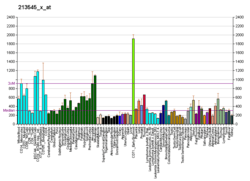SNX3
Sorting nexin-3 is a protein that in humans is encoded by the SNX3 gene.[5][6]
This gene encodes a member of the sorting nexin family. Members of this family contain a phox (PX) domain, which is a phosphoinositide binding domain, and are involved in intracellular trafficking. This protein does not contain a coiled coil region, like most family members. This protein interacts with phosphatidylinositol-3-phosphate, and is involved in protein trafficking.[6]
References
- 1 2 3 GRCh38: Ensembl release 89: ENSG00000112335 - Ensembl, May 2017
- 1 2 3 GRCm38: Ensembl release 89: ENSMUSG00000019804 - Ensembl, May 2017
- ↑ "Human PubMed Reference:".
- ↑ "Mouse PubMed Reference:".
- ↑ Haft CR, de la Luz Sierra M, Barr VA, Haft DH, Taylor SI (Dec 1998). "Identification of a Family of Sorting Nexin Molecules and Characterization of Their Association with Receptors". Mol Cell Biol. 18 (12): 7278–87. doi:10.1128/mcb.18.12.7278. PMC 109309. PMID 9819414.
- 1 2 "Entrez Gene: SNX3 sorting nexin 3".
Further reading
- Parks WT, Frank DB, Huff C, et al. (2001). "Sorting nexin 6, a novel SNX, interacts with the transforming growth factor-beta family of receptor serine-threonine kinases". J. Biol. Chem. 276 (22): 19332–9. doi:10.1074/jbc.M100606200. PMID 11279102.
- Xu Y, Hortsman H, Seet L, et al. (2001). "SNX3 regulates endosomal function through its PX-domain-mediated interaction with PtdIns(3)P". Nat. Cell Biol. 3 (7): 658–66. doi:10.1038/35083051. PMID 11433298.
- Vervoort VS, Viljoen D, Smart R, et al. (2003). "Sorting nexin 3 (SNX3) is disrupted in a patient with a translocation t(6;13)(q21;q12) and microcephaly, microphthalmia, ectrodactyly, prognathism (MMEP) phenotype". J. Med. Genet. 39 (12): 893–9. doi:10.1136/jmg.39.12.893. PMC 1757218. PMID 12471201.
- Strausberg RL, Feingold EA, Grouse LH, et al. (2003). "Generation and initial analysis of more than 15,000 full-length human and mouse cDNA sequences". Proc. Natl. Acad. Sci. U.S.A. 99 (26): 16899–903. doi:10.1073/pnas.242603899. PMC 139241. PMID 12477932.
- Gevaert K, Goethals M, Martens L, et al. (2004). "Exploring proteomes and analyzing protein processing by mass spectrometric identification of sorted N-terminal peptides". Nat. Biotechnol. 21 (5): 566–9. doi:10.1038/nbt810. PMID 12665801.
- Mungall AJ, Palmer SA, Sims SK, et al. (2003). "The DNA sequence and analysis of human chromosome 6". Nature. 425 (6960): 805–11. doi:10.1038/nature02055. PMID 14574404.
- Gerhard DS, Wagner L, Feingold EA, et al. (2004). "The Status, Quality, and Expansion of the NIH Full-Length cDNA Project: The Mammalian Gene Collection (MGC)". Genome Res. 14 (10B): 2121–7. doi:10.1101/gr.2596504. PMC 528928. PMID 15489334.
- Beausoleil SA, Villén J, Gerber SA, et al. (2006). "A probability-based approach for high-throughput protein phosphorylation analysis and site localization". Nat. Biotechnol. 24 (10): 1285–92. doi:10.1038/nbt1240. PMID 16964243.
- Olsen JV, Blagoev B, Gnad F, et al. (2006). "Global, in vivo, and site-specific phosphorylation dynamics in signaling networks". Cell. 127 (3): 635–48. doi:10.1016/j.cell.2006.09.026. PMID 17081983.
- Kumar RA, Everman DB, Morgan CT, et al. (2007). "Absence of mutations in NR2E1 and SNX3 in five patients with MMEP (microcephaly, microphthalmia, ectrodactyly, and prognathism) and related phenotypes". BMC Med. Genet. 8: 48. doi:10.1186/1471-2350-8-48. PMC 1950490. PMID 17655765.
This article is issued from
Wikipedia.
The text is licensed under Creative Commons - Attribution - Sharealike.
Additional terms may apply for the media files.





